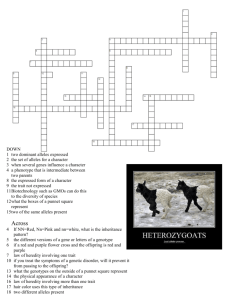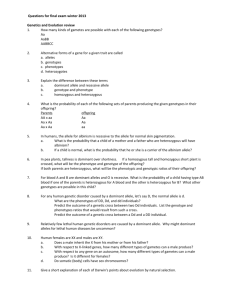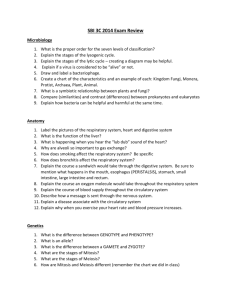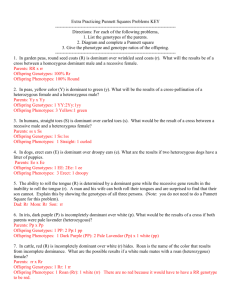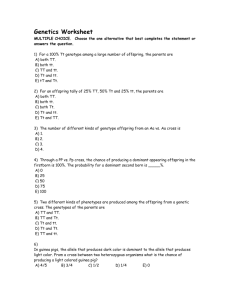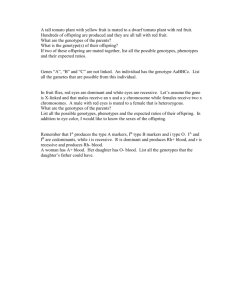Genetics Problems Set
advertisement
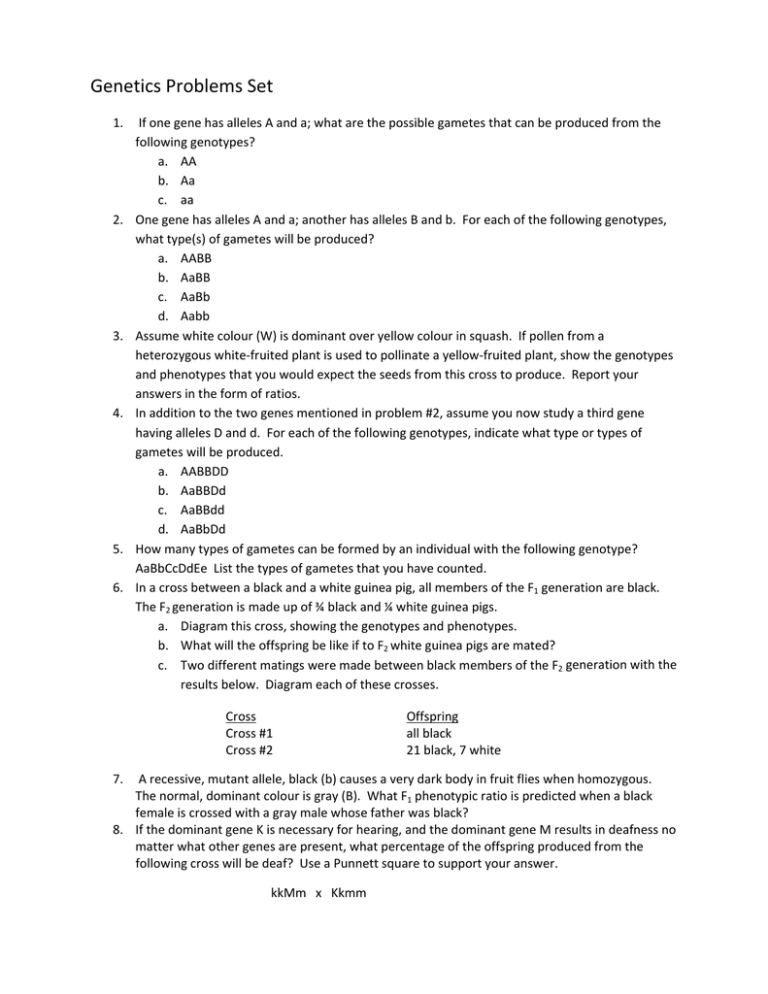
Genetics Problems Set 1. If one gene has alleles A and a; what are the possible gametes that can be produced from the following genotypes? a. AA b. Aa c. aa 2. One gene has alleles A and a; another has alleles B and b. For each of the following genotypes, what type(s) of gametes will be produced? a. AABB b. AaBB c. AaBb d. Aabb 3. Assume white colour (W) is dominant over yellow colour in squash. If pollen from a heterozygous white‐fruited plant is used to pollinate a yellow‐fruited plant, show the genotypes and phenotypes that you would expect the seeds from this cross to produce. Report your answers in the form of ratios. 4. In addition to the two genes mentioned in problem #2, assume you now study a third gene having alleles D and d. For each of the following genotypes, indicate what type or types of gametes will be produced. a. AABBDD b. AaBBDd c. AaBBdd d. AaBbDd 5. How many types of gametes can be formed by an individual with the following genotype? AaBbCcDdEe List the types of gametes that you have counted. 6. In a cross between a black and a white guinea pig, all members of the F1 generation are black. The F2 generation is made up of ¾ black and ¼ white guinea pigs. a. Diagram this cross, showing the genotypes and phenotypes. b. What will the offspring be like if to F2 white guinea pigs are mated? c. Two different matings were made between black members of the F2 generation with the results below. Diagram each of these crosses. Cross Cross #1 Cross #2 Offspring all black 21 black, 7 white 7. A recessive, mutant allele, black (b) causes a very dark body in fruit flies when homozygous. The normal, dominant colour is gray (B). What F1 phenotypic ratio is predicted when a black female is crossed with a gray male whose father was black? 8. If the dominant gene K is necessary for hearing, and the dominant gene M results in deafness no matter what other genes are present, what percentage of the offspring produced from the following cross will be deaf? Use a Punnett square to support your answer. kkMm x Kkmm 9. In hogs, the allele that produces a white belt around the body (B) is dominant over the allele for a uniformly coloured body (b). Another gene (F) produces fused hooves on each foot while it’s recessive(f) produces normal hooves. Suppose a uniformly coloured hog homozygous for fused hooves is mated with a normal footed hog homozygous for the belted trait. What would be the genotypes and phenotypes in the F1 generation? If the F1 individuals were allowed to interbreed, what phenotypic and genotypic ratios would you predict for the F2 generation? Use a Punnett square to support your answer. 10. In cats, long tails (TL) and no tails (TN) are incompletely dominant. The heterozygous condition results in short tails. Using a Punnett square, give the genotypic and phenotypic ratios for the offspring of a cross between two short‐tailed cats. 11. In snapdragons, red flower colour (CR) is dominant to white (CW). The heterozygous condition produces pink flowers. Normal broad leaves (LB) are codominant with narrow grass‐like leaves (LN). The heterozygous condition produces an intermediate leaf width. If a red‐flowered, broad‐ leafed plant is crossed with a white‐flowered narrow‐leafed plant, what will be the appearance of the F1 and the F2 progeny? 12. When sown, the seed collected from a cross between a dwarf tomato plant, with cut leaves and a tall tomato plant with entire leaves gave rise to tomato plants which were all tall and had cut leaves. These plants were self‐pollinated and the resulting seeds gave rise to the following generation of plants: i. 611 tall plants with cut leaves ii. 208 tall plants with entire leaves iii. 212 dwarf plants with cut leaves iv. 69 dwarf plant with entire leaves a. Provide a clear genetic explanation of these results. b. Describe how you would attempt to establish a line of pure‐breeding tall plants with cut leaves from among the class (i) plants. 13. Shown below are five maternal and paternal phenotypes (1‐5), each designating the ABO, MN and Rh blood group antigens. Each combination resulted in one of the five offspring shown to the right (a‐e). Arrange the offspring with the correct parents such that all five cases are consistent. Is there more than one correct set of answers? Parental phenotypes offspring (1) A, M, Rh‐ x A, N, Rh‐ (a) A, N, Rh‐ ‐ + (2) B, M, Rh x B, M, Rh (b) O, N, Rh+ (3) O, N, Rh+ x B, N, Rh+ (c) O, MN, Rh‐ ‐ + (4) AB, M, Rh x O, N, Rh (d) B, M, Rh+ ‐ ‐ (5) AB, MN, Rh x AB, MN, Rh (e) B, MN, Rh+ 14. A husband and wife have normal vision, although both of their fathers are red‐green colourblind, which is inherited as a sex‐linked recessive condition. What is the probability that their first child will be a. a normal son? b. a normal daughter? c. a colourblind son? d. a colourblind daughter? 15. In humans, the ABO blood type is under the control of autosomal multiple alleles. Colour blindness is a recessive sex‐linked trait. If two parents who are both type A and have normal vision produce a son who is colourblind and is type O, what is the probability that their next child will be a female who has normal vision and is type O?



